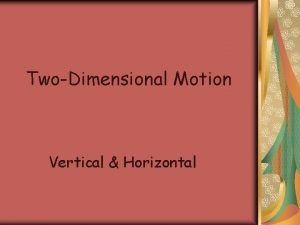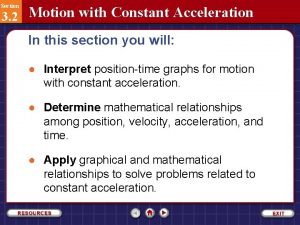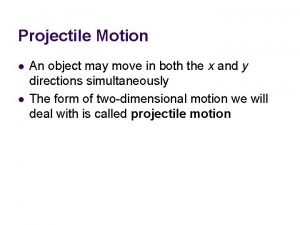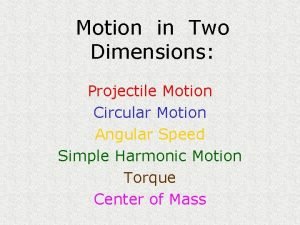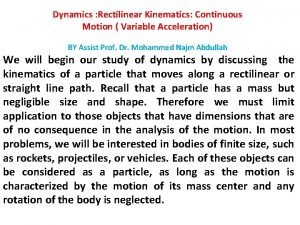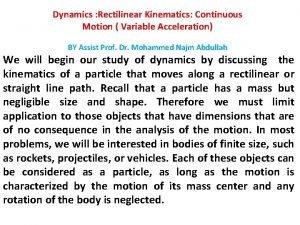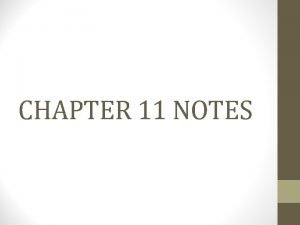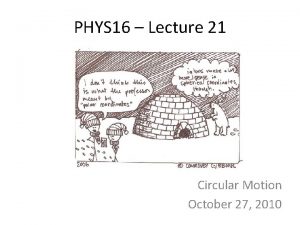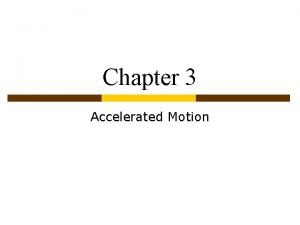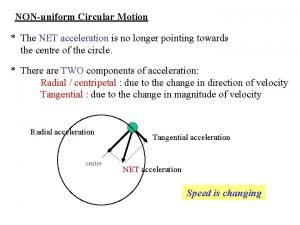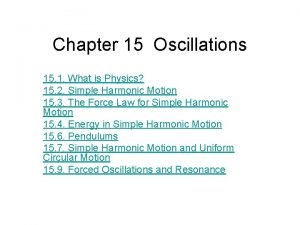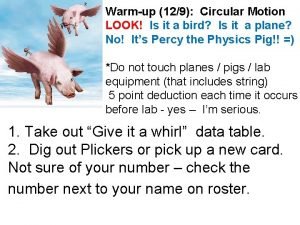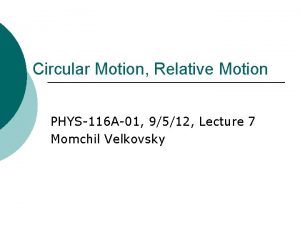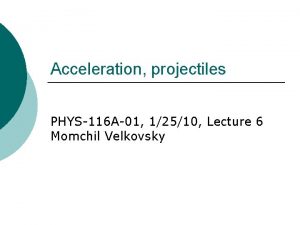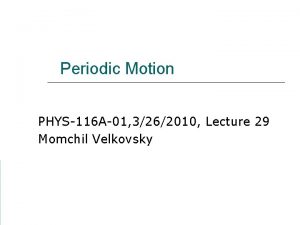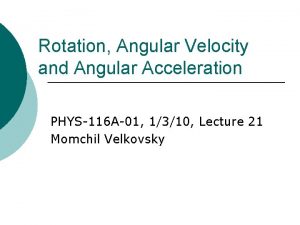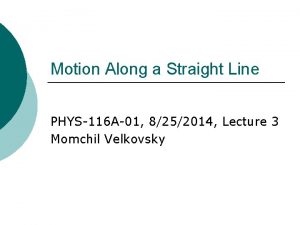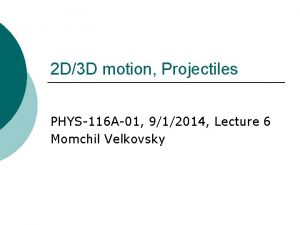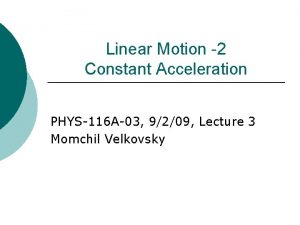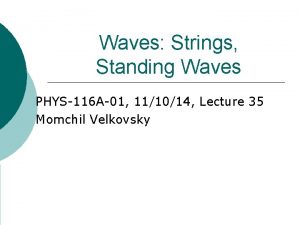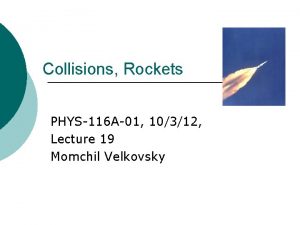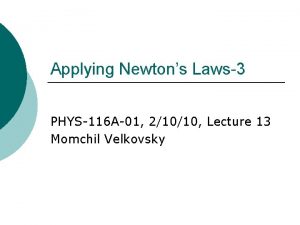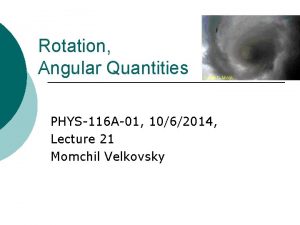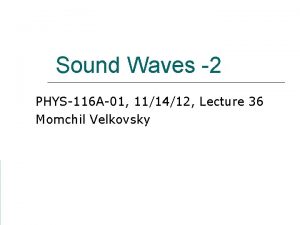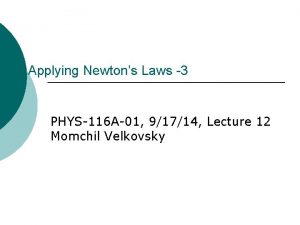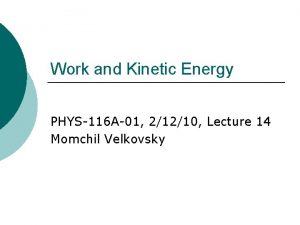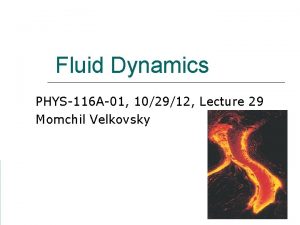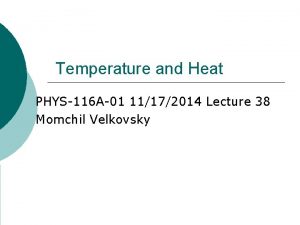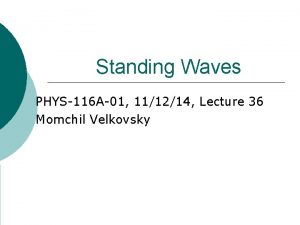Linear motion 2 Acceleration PHYS116 A01 8272014 Lecture




















- Slides: 20

Linear motion 2 (Acceleration) PHYS-116 A-01, 8/27/2014, Lecture 4 Momchil Velkovsky

v-t and x-t graphs I need to know my initial position!

v(m/s) Constant acceleration 4 3 v(3 s)= v 0+ Dv(3 s) = v 0+ a*3 s Area= Dx=v(t)*Dt 2 1 v 0 0 0 1 Dt Dt Dt 2 3 4 v(t)=v 0+at Dx= v 0 t+1/2 Dv(t) t = v 0 t+1/2 a t 2 5 6 7 t(s)

v(m/s) Variable acceleration 4 3 2 1 v 0 0 0 1 Dt Dt Dt 2 3 4 5 6 7 t(s)

Constant acceleration y(t) Free fall a=-g=-9. 8 m/s 2 y t

You toss a ball straight upward, in the positive direction. The ball falls freely under the influence of gravity. At the highest point in the ball’s motion, 1. 2. 3. 4. 5. A. its velocity is zero and its acceleration is zero. B. its velocity is zero and its acceleration is positive (upward). C. its velocity is zero and its acceleration is negative (downward). D. its velocity is positive (upward) and its acceleration is zero. E. its velocity is positive (upward) and its acceleration is zero.

Excluding time or acceleration

Mystery Graphs


Two bodies with different accelerations At the moment when the speeding motorist passes by the sign, the policeman who waits there starts a chase and catches him. • At what time counting from the initial moment is this event going to happen? • At what distance from the sign the policeman will overcome the motorist?

Which v-t graph is correct? 1. 2. 3. 4. a b c d

Two bodies with different accelerations

This is the x–t graph of the motion of a particle. Of the four points P, Q, R, and S, the velocity v is greatest (most positive) at… 1. 2. 3. 4. 5. P Q R S Not enough information

This is the x–t graph of the motion of a particle. Of the four points P, Q, R, and S, the speed is greatest at … 1. 2. 3. 4. 5. P Q R S Not enough information

This is the x–t graph of the motion of a particle. Of the four points P, Q, R, and S, the acceleration a is greatest (most positive) at … 1. 2. 3. 4. 5. P Q R S Not enough information

This is a motion diagram of an object moving along the x– direction with constant acceleration. The dots 1, 2, 3, … show the position of the object at equal time intervals ∆t. 5 4 3 2 1 x x=0 At the time labeled 3, what are the signs of the object’s velocity vx and acceleration ax? 1. 2. 3. 4. 5. A. v < 0, a = 0 B. v < 0, a > 0 C. v < 0, a < 0 D. v > 0, a > 0 E. v > 0, a < 0

Which of the following v–t graphs best matches the motion shown in the motion diagram? vx vx t 0 A. 0 B. 1. 2. 3. 4. 5. A. B. C. D. E. vx t 0 C. vx t 0 D. vx t 0 E. t

Which of the following a–t graphs best matches the motion shown in the motion diagram? ax ax t 0 A. 0 B. 1. 2. 3. 4. 5. A. B. C. D. E. ax t 0 C. ax t 0 D. ax t 0 E. t

This is the v–t graph for an object moving along the x -axis. Which of the following descriptions of the motion is most accurate? 1. 2. 3. 4. 5. The The The object is slowing down at a decreasing rate. object is slowing down at an increasing rate. object is speeding up at a decreasing rate. object is speeding up at an increasing rate. object’s speed is changing at a steady rate.

Next time Read 3. 1 -3. 7 and 4. 1 -4. 4 ¡ Do the reading question ¡
 Relation between linear and angular quantities
Relation between linear and angular quantities Kinetic angular energy
Kinetic angular energy Linear motion with constant acceleration
Linear motion with constant acceleration Is radial acceleration the same as centripetal acceleration
Is radial acceleration the same as centripetal acceleration Radial acceleration formula
Radial acceleration formula Centripetal acceleration tangential acceleration
Centripetal acceleration tangential acceleration 01:640:244 lecture notes - lecture 15: plat, idah, farad
01:640:244 lecture notes - lecture 15: plat, idah, farad Example of vertical motion of galilean
Example of vertical motion of galilean Translational motion diagram
Translational motion diagram Motion section 3 acceleration
Motion section 3 acceleration Non symmetric projectile motion
Non symmetric projectile motion Acceleration formula in circular motion
Acceleration formula in circular motion Vertical motion acceleration
Vertical motion acceleration Define variable acceleration
Define variable acceleration What is continuous motion in dynamics
What is continuous motion in dynamics Chapter 11 motion section 2 acceleration answer key
Chapter 11 motion section 2 acceleration answer key Circular motion
Circular motion Motion section 3 acceleration
Motion section 3 acceleration Net acceleration in circular motion
Net acceleration in circular motion K=mω^2
K=mω^2 Centripetal velocity formula
Centripetal velocity formula







